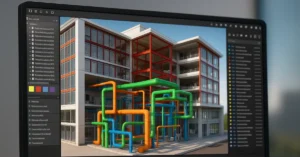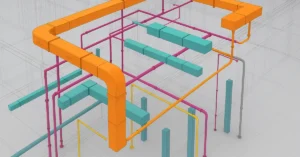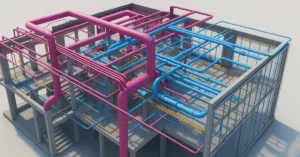Discover the powerful and enduring brutalist buildings in Guangzhou that reflect a unique chapter of China’s architectural journey
Guangzhou, a bustling metropolis and the capital of Guangdong province, is often celebrated for its rapid modernization, Canton Tower, and sprawling skyscrapers. Yet tucked amidst this hyper-urban landscape lies a quieter, more rigid architectural narrative—the story of brutalist buildings in Guangzhou. While brutalism is often associated with Europe or North America, its influence extended powerfully into East Asia, particularly during the mid-20th century when ideology, functionality, and architectural experimentation intersected.
In this blog, we uncover the lesser-known yet highly significant brutalist buildings that dot the cityscape of Guangzhou. These concrete giants tell tales of political shifts, industrial aspirations, and a unique architectural evolution. As we tour these bold structures, we will explore their design, function, cultural symbolism, and what they mean for the future of the city’s architectural identity.
Understanding Brutalism in China’s Urban Context
Brutalism in China emerged during a time of great transformation. The mid-20th century was marked by political revolution, infrastructural ambition, and a deep desire for modernity. China, like many socialist states, embraced architecture not just for form and function, but as an ideological tool. Concrete became a symbol of strength, permanence, and unity.
In Guangzhou, brutalist architecture often intersected with institutional development—universities, government buildings, cultural centers, and factories. Unlike the decorative elegance of traditional Chinese architecture, brutalist buildings featured exposed concrete, raw finishes, modular forms, and an overt focus on mass and volume.
Top Brutalist Buildings in Guangzhou
1. Sun Yat-sen University Campus Structures
Location: Haizhu District, Guangzhou
Period: 1950s–1970s
Sun Yat-sen University, one of China’s oldest and most prestigious institutions, is home to several brutalist-style academic buildings built during the socialist era. These include classroom blocks and administration buildings that feature massive concrete columns, repetitive window patterns, and little ornamentation. Their austere appearance reflects the utilitarian purpose of education during a transformative era.
2. Guangzhou Gymnasium
Location: Baiyun New Town, Guangzhou
Architect: Paul Andreu (French Architect)
Year Completed: 2001
While constructed in the 21st century, the Guangzhou Gymnasium retains strong brutalist influences with its heavy, fortress-like appearance. The structure’s concrete massing, aggressive angular geometry, and minimal facade detailing place it at the intersection of brutalism and modernism. It is used for sporting events and cultural performances, making it one of the city’s key public venues.
3. Guangdong Science Center Auxiliary Structures
Location: University Town, Xiaoguwei Island, Guangzhou
Year Completed: 2008
Although the main building showcases futuristic elements, several adjacent facilities and maintenance buildings within the Science Center complex reflect brutalist design principles. Their exposed concrete walls, industrial efficiency, and blocky silhouettes provide contrast to the sleek curves of the primary structure.
4. Former Factory Buildings in Haizhu and Liwan Districts
Period: 1950s–1980s
Guangzhou’s industrial past has left behind a wealth of brutalist-style factory buildings, particularly in Haizhu and Liwan districts. These concrete giants, often abandoned or repurposed into creative spaces, exhibit raw materiality and structural clarity. High ceilings, thick walls, and vast interiors characterize their practical yet bold designs.
5. Guangzhou No. 2 People’s Hospital Administrative Block
Location: Yuexiu District, Guangzhou
Period: Late 1970s
This public health facility showcases brutalist aesthetics in its administrative block, featuring straight vertical lines, reinforced concrete framing, and minimal decoration. As with many state-built institutions of the era, the building prioritized strength and function over visual appeal.
6. Guangzhou Railway Bureau Offices
Location: Yuexiu South Road, Guangzhou
Period: 1960s
This mid-century governmental structure is an excellent example of institutional brutalism in China. The building’s solid concrete construction, utilitarian grid of windows, and pronounced facade fins reflect the era’s emphasis on mass production and durability.
7. Worker’s Cultural Palace Buildings
Location: Haizhu Square, Guangzhou
Period: Mid-20th century
These state-sponsored cultural centers were built to provide ideological education and recreational facilities for workers. The design of these structures featured a monolithic, block-like appearance with wide staircases, vast halls, and concrete facades. Though many have been renovated, echoes of their brutalist roots remain.
The Cultural and Political Influence of Brutalism in Guangzhou
Unlike many Western countries where brutalism was an architectural choice driven by aesthetics and innovation, in Guangzhou, brutalism was more politically charged. Under Maoist ideology, architecture served as a manifestation of the collective, the uniform, and the permanent.
The widespread use of concrete was not only practical—it symbolized the authority and permanence of the Communist regime. These buildings were meant to stand the test of time, physically and ideologically. Guangzhou’s brutalist buildings are not merely examples of architectural form; they are monuments to a specific vision of governance, identity, and social structure.
Why These Buildings Matter Today
Today, as China modernizes at an unprecedented rate, many brutalist buildings in Guangzhou face demolition or heavy renovation. Glass towers and mixed-use skyscrapers now dominate the skyline, erasing traces of the city’s architectural past. This transformation raises important questions about historical preservation, urban identity, and cultural memory.
Brutalist architecture, with all its divisiveness, challenges us to reconsider our definitions of beauty, utility, and significance. For architects and urban planners, these structures offer valuable lessons in material efficiency, spatial economy, and ideological symbolism. For the general public, they offer a tangible connection to the city’s evolution.
Preservation Challenges and Adaptive Reuse
Despite growing interest, preservation efforts remain limited. Brutalist structures are often perceived as outdated or unattractive, making them easy targets for redevelopment. In Guangzhou, where land value and urban expansion drive decision-making, architectural heritage frequently takes a backseat.
However, adaptive reuse is emerging as a sustainable solution. Former factories have become art spaces, libraries, or tech hubs. These projects breathe new life into old structures while retaining their historical integrity. With proper investment and public awareness, more brutalist buildings could be reimagined for the future.
A Brutalist Walking Tour: Exploring Guangzhou’s Concrete Legacy
For those curious about exploring brutalist architecture in Guangzhou, a self-guided walking tour could include:
- Sun Yat-sen University Campus – Academic brutalism at its finest.
- Guangzhou Gymnasium – For fans of contemporary brutalist fusion.
- Former Haizhu Factories – A journey into industrial brutalism.
- Guangzhou No. 2 Hospital – Public service structures with historic value.
These locations offer a glimpse into different facets of brutalism—educational, governmental, industrial, and cultural—making for a rich and thought-provoking experience.
Conclusion
Brutalist buildings in Guangzhou are more than remnants of a rigid design philosophy; they are silent witnesses to an era of rapid transformation, ideological expression, and structural ambition. Though often misunderstood, these structures continue to evoke strong emotional and intellectual reactions.
As cities like Guangzhou chart paths toward futuristic skylines, it is essential not to forget the architectural milestones that paved the way. Whether through preservation, reuse, or reinterpretation, brutalist buildings deserve a place in the dialogue about urban identity and cultural continuity.
For those who dare to look beyond the glass and steel, Guangzhou’s brutalist legacy offers a raw, honest, and unfiltered look into the past—and perhaps, into the values we want to carry into the future.
If you’re interested in learning more about architecture firms in Europe, check out this comprehensive list of the top 50 firms compiled by Archgyan. From innovative startups to long-established industry leaders, this list has it all. Take a look and discover some of the most inspiring and influential architecture firms in Europe today.
If you’re interested in architecture and want to learn more about this amazing field, subscribe to our podcast on youtube
For more SketchUp tutorials, head to https://www.sketchupguru.com










